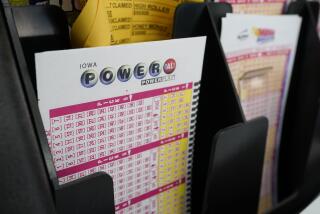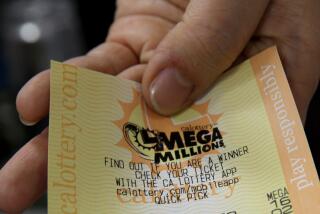State Lottery Sales Reach Record High
SACRAMENTO — People bought more than $3 billion in California Lottery tickets this fiscal year, a record for the nearly 20-year-old games.
Officials attributed much of the rise not to the flashy 12-state Mega Millions game that debuted last week, but to a burst in the popularity of Scratchers, in which players scrape a coating from tickets to reveal potential winning numbers.
After some of Scratchers’ dozens of themed games were tweaked last year to include interactive elements and more-lucrative prizes, their sales jumped by $375 million to roughly $1.7 billion.
“This is the best year ever,” Director Chon Gutierrez told the Lottery Commission on Wednesday.
Overall lottery sales that hovered below $3 billion in each of the last four years will finally cross that mark, with $3.3 billion in revenue expected by today’s close of the fiscal year.
Though state law requires that 34% of lottery sales money go to public schools, the rising revenue isn’t enough to make up for what many education officials say they should be receiving from the state budget. The more than $1 billion the lottery will give this year to public schools, from kindergartens to colleges, amounts to less than 2% of all spending on education.
The California game’s all-time-high sales this year ranked it fifth overall compared with other state-run lotteries, according to figures compiled by lottery staff. New York led with $5 billion in sales, followed by Massachusetts, Texas and Florida.
In terms of how much Californians spent per capita on the lottery last year -- $81 -- the state ranks 29th. Top spenders live in Massachusetts, which plows a higher percentage of its lottery sales back into prizes. Massachusetts residents spent $681 per capita last year on lottery tickets.
Mega Millions, which pools players from 12 states and offers bigger jackpots but steeper odds, got off to a strong start, generating an additional $2 million for public schools in just one week, officials said.
Hoping that the new game will drive up annual sales by $300 million to $500 million next year, the four members of the Lottery Commission adopted a target of $3.65 billion in total sales for 2005-06.
Mega Millions was launched June 22; two drawings have been held so far. No one won the jackpot either time, so the prize has rolled over and stands at an estimated $63 million for Friday’s drawing.
Californians spent $9.2 million last week buying tickets for the two Mega Millions draws, Gutierrez said. As expected, the new game diverted some players from SuperLotto Plus, the lottery’s other big game. SuperLotto sales dipped last Friday by $1.4 million.
Mega Millions’ “sales are right on pace with what we estimated, and education will benefit by at least $100 million [a year] if it stays on track,” Gutierrez said.
When California’s lottery was launched in 1986, the simple Scratchers games proved popular, with sales of $1.8 billion. But the novelty soon wore off. Scratchers sales plummeted over the next six years to a low of $310 million, rose somewhat in the late 1990s and then stagnated.
A sales turnaround started last year as lottery officials added new, more interactive bingo and crossword-like games, introduced $3 and $5 games and began giving out more-lucrative prizes.
By state law, the lottery must use at least 50% of its revenue for prize payout. But lottery officials gambled that higher Scratchers payouts -- the equivalent of 59% of sales revenue -- would spur sales.
So this year they increased prizes with $40 million they had saved in annual administrative costs by switching from a telephone-based system to satellites to connect lottery headquarters with thousands of gas stations, grocery stores and liquor stores where tickets are sold.
The higher Scratchers payouts were not advertised, but Gutierrez said the news spread by word of mouth. The higher Scratchers sales proved three times more valuable to schools than had the $40 million been shifted into school accounts, he said.
Such higher payouts -- and sales -- can’t be maintained, Gutierrez said, unless lawmakers give the lottery more flexibility to pay less than 34% of game revenue to schools and instead use the money to boost prizes and generate higher overall sales.
A bill to give the lottery such flexibility died last year in an Assembly committee in the face of opposition from the California Teachers Assn.


